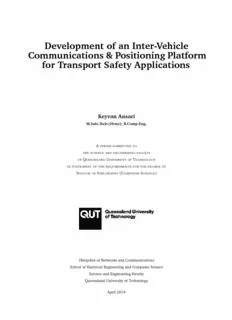
Development of an Inter-Vehicle Communications & Positioning Platform for Transport Safety ... PDF
Preview Development of an Inter-Vehicle Communications & Positioning Platform for Transport Safety ...
Development of an Inter-Vehicle Communications & Positioning Platform for Transport Safety Applications Keyvan Ansari M.Info.Tech.(Hons);B.Comp.Eng. A THESIS SUBMITTED TO THE SCIENCE AND ENGINEERING FACULTY OF QUEENSLAND UNIVERSITY OF TECHNOLOGY IN FULFILMENT OF THE REQUIREMENTS FOR THE DEGREE OF DOCTOR OF PHILOSOPHY (COMPUTER SCIENCE) DisciplineofNetworksandCommunications SchoolofElectricalEngineeringandComputerScience ScienceandEngineeringFaculty QueenslandUniversityofTechnology April2014 Development of an Inter-Vehicle Communications & Positioning Platform for Transport Safety Applications A THESIS SUBMITTED TO THE SCIENCE AND ENGINEERING FACULTY OF QUEENSLAND UNIVERSITY OF TECHNOLOGY IN FULFILMENT OF THE REQUIREMENTS FOR THE DEGREE OF DOCTOR OF PHILOSOPHY (COMPUTER SCIENCE) Keyvan Ansari M.Info.Tech.(Hons);B.Comp.Eng. Supervisor: ProfessorYanmingFeng DisciplineofNetworksandCommunications SchoolofElectricalEngineeringandComputerScience ScienceandEngineeringFaculty QueenslandUniversityofTechnology April2014 ii CopyrightinRelationtoThisThesis (cid:13)c Copyright2014byKeyvanAnsari. Allrightsreserved. StatementofOriginalAuthorship Theworkcontainedinthisthesishasnotbeenpreviouslysubmittedtomeetrequirementsforanawardat thisoranyotherhighereducationinstitution. Tothebestofmyknowledgeandbelief,thethesiscontains nomaterialpreviouslypublishedorwrittenbyanotherpersonexceptwhereduereferenceismade. QUT Verified Signature Signature: Date: 30thofApril,2014 iii iv Thisthesisisgratefullydedicated tomycompassionatewifeNazanin,whoseboundlesslove,patienceandsupportenabledmetoaccomplishthiswork; and tomymercifulparentsforalltheirencouragement,supportandfaith. Theyaretheinspirationofmylife. Thankyouallforyourgeneroussupport. KeyvanAnsari v vi Abstract Collisions among road vehicles and between road and rail vehicles have severe consequences such as high levels of injuries and fatalities, and significant financial losses. The number of crashes occurring betweenmotorvehiclesandtrainsrevealsthatsafetyissuesatlevelcrossingsarevitalforbothroadand railusers. Althoughresearchersrecognizethis,littleattentionhasbeengiventothedevelopmentofthe next generation safety systems dedicated to level crossings, such as the Cooperative Level Crossing safety systems (CLXs) proposed in this thesis. These hybrid systems, developed based on Cooperative Intelligent Transportation Systems (C-ITS), have the potential to form seamless Vehicular Ad-hoc Networks (VANETs) on roads and rail networks together, to facilitate safety-based Inter-Vehicle Communications (IVC) and Inter-Vehicle Positioning (IVP) among cars and trains. Wireless communications and precise positioning are the two key components of CLXs to make the systems’ safety-relatedtaskseffective. Two primary technical challenges exist for modeling a hybrid C-ITS served for safety on roads, on rail networks and at road/rail level crossings. Firstly, a hybrid C-ITS contains trains as a second type of vehicle other than road vehicles, by which a number of exclusive characteristics different to that of any conventional IVC systems is imposed on the vehicular network of the hybrid C-ITS. Secondly, the current Global Navigation Satellite Systems (GNSS)-based vehicle positioning systems utilizing digital road-map databases provide mainly route guidance for road users; however, the road-level positioning accuracy is not precise enough for most safety-of-life applications of C-ITS. This research contributes to the development of an integrated IVC and IVP platform for road and level crossing safety applications; this development is based on the emerging 5.9 GHz Dedicated Short-Range Communications (DSRC) and Real-Time Kinematic (RTK) Global Positioning System (GPS) technologies. To this end, the issues and technical approaches that are involved in designing an effective vehicular safety communications, networkingandpositioningarchitectureservingbothroadandrailusersareinvestigatedindetail. The main aim of this research is threefold: (1) the design, implementation and evaluation of a geographic-based wireless communication protocol (geo-multicast), which improves the reliability and efficiency of routing and data dissemination over VANETs; (2) the development of a data streaming mechanism and processing at vehicle end for GNSS-based IVP to achieve precise relative vehicle positioning in highly dynamic environments; (3) the experimental demonstration of the communications and positioning performance of the integrated IVC and IVP system, towards further developing such safety systems. The series of technological solutions provided throughout the thesis vii advance vehicular safety by combining the DSRC and GPS-based positioning technologies. In order to conduct this research, communications, networking and positioning models are developed from which simulationsandfieldexperimentsareconductedtoevaluatetheoverallperformanceofthesystem. The outcomes of this research significantly contribute to improving the performance of the communications and positioning components of CLX safety systems and of C-ITS in general, although the formulation anddevelopmentofafullyoperationalCLXsystemarebeyondthescopeofthisresearch. Inthisregard, thisthesispresentsthedesign,developmentandevaluationofthefollowingoriginalcontributions: • ApreciseIVPsystembasedonGNSSandIVC,supportingsafetyoperationsofC-ITS. • A geographic-based wireless communications protocol improving the reliability and efficiency of messagetransmissionoverVANETs. • AneffectiveIVCmessagedisseminationcontrolmechanismsupportingtherequirementsofprecise IVP. • A GNSS data-streaming protocol and processing mechanism at vehicle end to achieve precise relativevehiclepositioninginhighlydynamicenvironments. • Aself-integrityandperformancemonitoringframeworkfortheproposedpreciseIVPsystem. viii
Description: